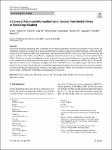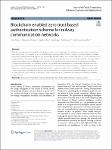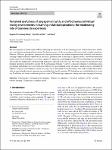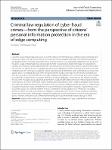Search
Author
- Osman, Ahmed I. (5)
- Daqing, Ma (3)
- Jorgensen, Ed (3)
- Li, Yan (3)
- next >
Subject
- kinh tế (26)
- Economics (12)
- programming (10)
- XRD (10)
- next >
Date issued
- 2020 - 2025 (2128)
- 2010 - 2019 (129)
- 2000 - 2009 (9)
- 1999 - 1999 (1)
Has File(s)
Search Results
The main objective of this research is to determine the perception of teachers about the elements that increases the educational effectiveness of gamified apps in primary education. A methodology based on an importance-performance analysis was daeveloped, using a structural equations model to calcuate the degree of importance of each variable. The sample was formed of 212 Spanish teachers with experience using educational apps in the teaching–learning process. Six categories were identified as precursors of educational effectiveness: (1) curriculum connection, (2) feedback and operational experience, (3) assessment and learning analytics, (4) sustainability (Protection Personal data), (5) equal access and (6) flow. These six categories enhance the three traditional areas of gamifica... |
Advanced knowledge engineering (KE), represented by knowledge graph (KG), drives the development of various fields and engineering technologies and provides various knowledge fusion and knowledge empowerment interfaces. At the same time, advanced system engineering (SE) takes model-based system engineering (MBSE) as the core to realize formal modeling and process analysis of the whole system. The two complement each other and are the key technologies for the transition from 2.0 to 3.0 in the era of artificial intelligence and the transition from perceptual intelligence to cognitive intelligence. This survey summarizes an advanced information fusion system, from model-driven to knowledge-enabled. Firstly, the concept, representative methods, key technologies and application fields of... |
This systematic review provides unique findings with an up-to-date examination of artificial intelligence (AI) in higher education (HE) from 2016 to 2022. Using PRISMA principles and protocol, 138 articles were identified for a full examination. Using a priori, and grounded coding, the data from the 138 articles were extracted, analyzed, and coded. The findings of this study show that in 2021 and 2022, publications rose nearly two to three times the number of previous years. With this rapid rise in the number of AIEd HE publications, new trends have emerged. The findings show that research was conducted in six of the seven continents of the world. |
With the introduction of emerging technologies such as cloud computing, the railway communication network has the characteristics of complex structure and blurred boundaries, which leads to a series of security threats including information leakage and malicious access. Specifically, the third-party cloud services are difficult to be supervised, and network traffic is untrustworthy. To ensure system security, we propose a zero-trust security model in this paper. Then, we introduce blockchain and Merkle tree to build a distributed identity storage scheme for guaranteeing reliable, confidential and efficient data updates, and improving authentication efficiency. |
Oral implantology is a science in constant evolution, with a considerable number of articles being published every year in scientific journals. Publications can be analyzed through bibliometric analysis, thus observing the evolution and trends of the articles published in the journal. To evaluate, through bibliometric analysis, the scientific production of Clinical Implant Dentistry and Related Research (CIDRR) and its evolution and trends in the last 5 years (2016–2020).All articles published in CIDRR in the last 5 years were reviewed and classified according to the year of publication, volume, number, the number of authors, demographic data of the first and last author, the geographical scope of the article, the number of affiliations of the authors, research topic, type of study,... |
To evaluate the security of a cryptographic primitive, investigating its resistance against differential and linear cryptanalysis is required. Many modern cryptographic primitives repeatedly apply similar round functions alternated with the addition of round keys or constants. A round function usually consists of a non-linear mapping and a number of linear mappings. The non-linear mapping χ is used in different cryptographic primitives such as KECCAK and SUBTERRANEAN. An alternative version of χ is used in ASCON and the non-linear layer of SIMON has the same differential and linear properties of χ. The mapping χ can be applied to strings with different lengths. |
The development of virtual reality (VR) in enhancing the effectiveness of the learning process, with its interactive, immersive, and intuitive pedagogical environment, has become a necessity for corporations with increasingly complex operations. However, VR users’ perceptions, openness and learning effectiveness are seldom comprehensively evaluated, particularly in learning complex industrial operations. In this study, grounded in the technology acceptance model, a moderated mediation model of perceived usefulness, ease of use, openness to experience, and engagement in VR-based learning was developed. The model was empirically validated using responses collected from 321 users who were trained on aircraft and cargo terminal operations powered by a novel VR-based learning platform. |
Currently, cloud computing provides users all over the globe with Information and Communication Technology facilities that are utility-oriented. This technology is trying to drive the development of data center design by designing and building them as networks of cloud machines, enabling users to access and run the application from any part of the globe. Cloud computing provides considerable benefits to organizations by providing rapid and adaptable ICT software and hardware systems, allowing them to concentrate on creating innovative business values for the facilities they provide. |
This study investigates how family continuation, namely family tradition and succession intention, alter the socially responsible behavior of small and medium sized (SME) family firms. Using a unique dataset, we have conducted multiple regressions on survey data from German family SMEs and show a statistically and economically significant increase in Corporate Social Responsibility (CSR) alongside the planning of family succession. However, when analyzing the different facets of CSR, we have found strong variances: While succession intention goes along with an increased community, market, and supply chain engagement this is not the case for CSR directed towards employees, or the environment. Family tradition didn’t correlate with a change in CSR behaviour to a relevant extent. In ou... |
‘Ecology of mind’ (Bateson, 1972) is a key concept applied to this project engaged in by a social anthropologist, a policy researcher, and a Sundanese Chief. Together we explore how the agendas for COP 26 could be attained and to what extent the Nobel economist Elinor Ostrom’s (2018) eight principles are relevant for managing the commons and key learnings that can be shared more broadly.The paper details the Sundanese forest community’s organisational systems to support living in ways that re-generate and sustain the forest and the way that the community has connected with Universitas Padjadjaran and an NGO called the Common Room Networks (common room.id), in order to support and extend their learning with nature program within and beyond Indonesia. |










